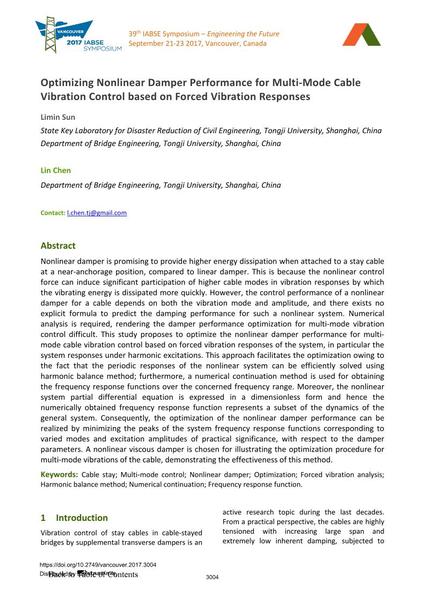Optimizing Nonlinear Damper Performance for Multi-Mode Cable Vibration Control based on Forced Vibration Responses

|
|
|||||||||||
Bibliographic Details
| Author(s): |
Limin Sun
Lin Chen |
||||
|---|---|---|---|---|---|
| Medium: | conference paper | ||||
| Language(s): | English | ||||
| Conference: | IABSE Symposium: Engineering the Future, Vancouver, Canada, 21-23 September 2017 | ||||
| Published in: | IABSE Symposium Vancouver 2017 | ||||
|
|||||
| Page(s): | 3004-3009 | ||||
| Total no. of pages: | 6 | ||||
| Year: | 2017 | ||||
| DOI: | 10.2749/vancouver.2017.3004 | ||||
| Abstract: |
Nonlinear damper is promising to provide higher energy dissipation when attached to a stay cable at a near-anchorage position, compared to linear damper. This is because the nonlinear control force can induce significant participation of higher cable modes in vibration responses by which the vibrating energy is dissipated more quickly. However, the control performance of a nonlinear damper for a cable depends on both the vibration mode and amplitude, and there exists no explicit formula to predict the damping performance for such a nonlinear system. Numerical analysis is required, rendering the damper performance optimization for multi-mode vibration control difficult. This study proposes to optimize the nonlinear damper performance for multi- mode cable vibration control based on forced vibration responses of the system, in particular the system responses under harmonic excitations. This approach facilitates the optimization owing to the fact that the periodic responses of the nonlinear system can be efficiently solved using harmonic balance method; furthermore, a numerical continuation method is used for obtaining the frequency response functions over the concerned frequency range. Moreover, the nonlinear system partial differential equation is expressed in a dimensionless form and hence the numerically obtained frequency response function represents a subset of the dynamics of the general system. Consequently, the optimization of the nonlinear damper performance can be realized by minimizing the peaks of the system frequency response functions corresponding to varied modes and excitation amplitudes of practical significance, with respect to the damper parameters. A nonlinear viscous damper is chosen for illustrating the optimization procedure for multi-mode vibrations of the cable, demonstrating the effectiveness of this method. |
||||
| Keywords: |
optimization cable stay Multi-mode control non-linear damper forced vibration analysis Harmonic balance method Numerical continuation Frequency response function
|
||||
